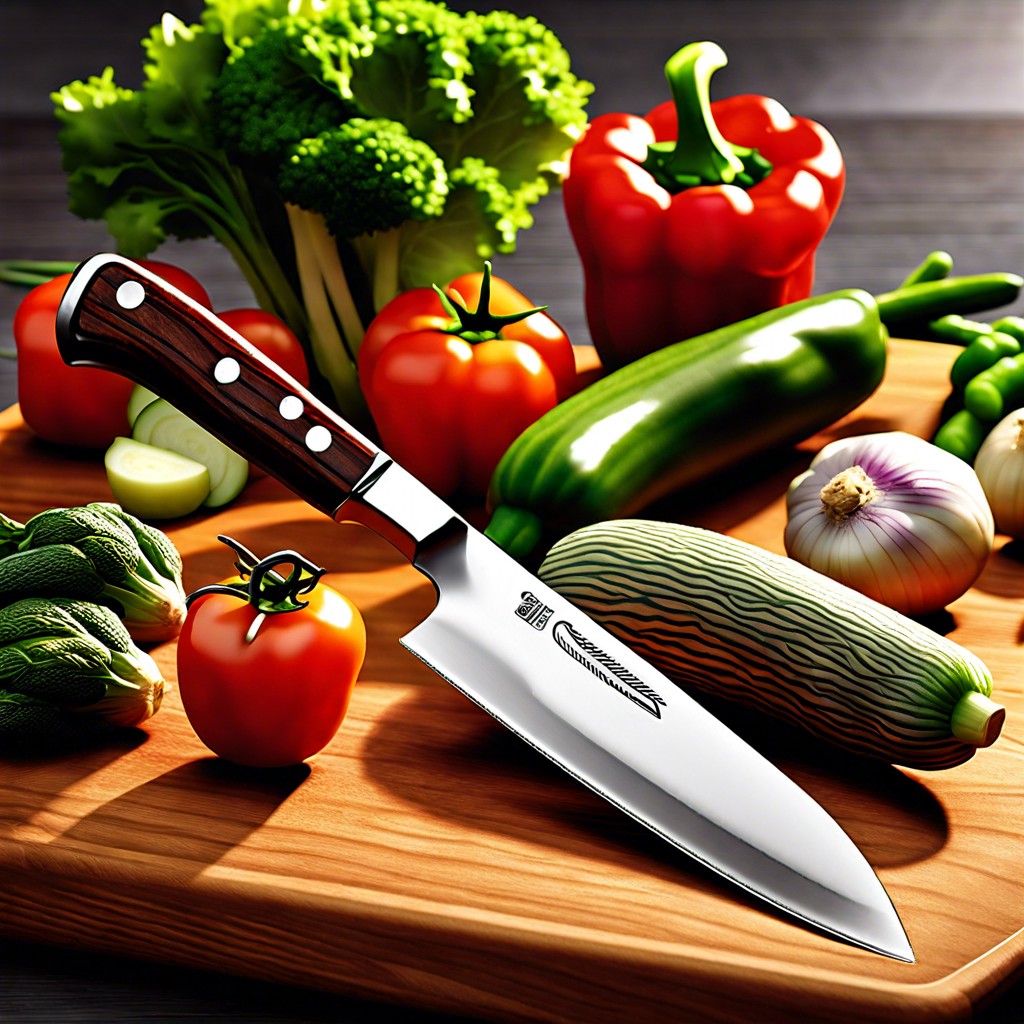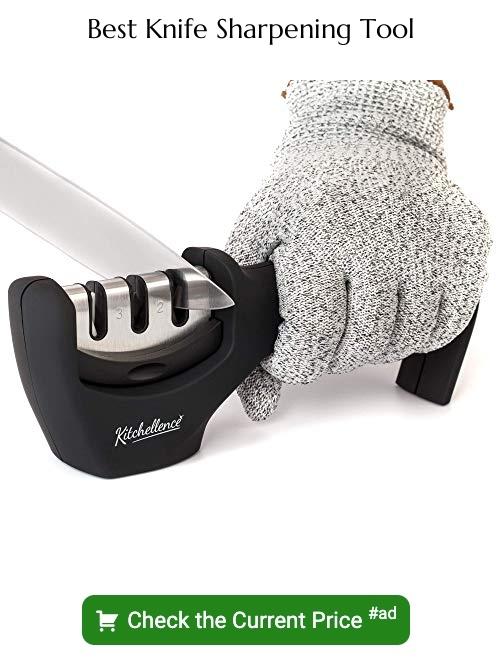Last updated on
Discover how the angle of knife sharpening influences cutting efficiency and learn the optimal angles for different types of knives.
Key takeaways:
- Keeping knives sharp reduces effort, enhances precision, and improves safety.
- The angle at which you sharpen a knife affects its sharpness and durability.
- Smaller angles (10-15 degrees) for delicate slicing, wider angles (20-25 degrees) for tougher tasks.
- Tools for sharpening: guided systems, whetstones, manual sharpeners, electric sharpeners, honing rods.
- Determine the right sharpening angle based on knife use and design.
What's Inside
Importance of Keeping Knives Sharp

A sharp knife is a chef’s best friend, and there’s a handful of reasons why maintaining that fine edge is essential. First, it reduces the effort required in cutting, slicing, or dicing, which in turn minimizes the risk of accidents. Dull blades require more force, potentially leading to slips and injuries.
Beyond safety, a keen edge delivers precision and efficiency. It glides through ingredients with ease, preserving their integrity and enhancing the presentation of dishes. When ingredients are cleanly cut, they also cook more evenly, ensuring a better culinary result.
Moreover, sharp knives are a testament to professional care. They extend the life of your tools, as proper maintenance means less frequent replacements. A well-kept blade reflects the level of respect and dedication one has for their craft.
In the realm of sharpening, remember that a dull knife isn’t just a nuisance — it’s a liability. By keeping your knives sharp, you ensure a safe, precise, and enjoyable cooking experience.
Understanding the Basics of Knife Sharpening Angles
The angle at which you sharpen a knife is the secret sauce to achieving a blade’s utmost utility and longevity. Think of this angle as the meeting point between the blade’s edge and the sharpening tool, which ranges from 10 to 30 degrees on each side. The finer the angle, the sharper but also more delicate the edge becomes. Conversely, a larger angle results in a sturdier edge but possibly less sharp.
Precision is key, and even a few degrees difference can transform a knife’s performance. The angle dictates not only the sharpness but also the durability of the edge. A common chef’s knife often finds a sweet spot around 20 degrees. Delicate slicers for sushi might dip closer to 10 degrees, demanding careful handling. Burly cleavers, on the other end of the spectrum, can go up to 30 degrees for the rough-and-tumble of chopping bones.
The concept might appear daunting at first, but as with any craft, practice coupled with a basic understanding of these principles will dramatically improve your knife’s edge. Remember, the goal is consistency. Maintaining a steady angle throughout the sharpening process ensures an even, razor edge, ready for action.
Differences Between Various Knife Angles
Knife angles are a vital factor in both the sharpness and durability of your blade. Think of it this way: the angle of your knife’s edge can dramatically impact its performance and lifespan.
A smaller angle, typically around 10-15 degrees per side, is seen in razor-sharp knives like those used for sushi. These knives slice through delicate items with precision but require more frequent sharpening as the edge can dull quickly.
Conversely, a wider angle, around 20-25 degrees per side, characterizes utility knives like those in your kitchen drawer. This angle offers a balance of sharpness and edge resilience, suitable for cutting through tougher materials without excessive wear.
For heftier tasks, such as chopping firewood or cutting carpet, an angle of 25-30 degrees per side provides a more robust edge that’s less prone to chipping or rolling.
Keep in mind, specialty knives may deviate from these standards due to their unique purposes. A fillet knife for fish, for instance, may benefit from a different angle than a cleaver designed for bones.
The key takeaway? The optimal angle for your knife depends on its intended use; sharper isn’t always better, and broader angles have their place in the toolbox for tougher jobs.
Tools You Can Use for Sharpening Knives
Having established what angles are best suited for your knives, let’s delve into the tools that will help you maintain that perfect edge. The market is abundant with options, each suiting different preferences and skill levels.
For beginners, a guided sharpening system is a go-to. It removes the guesswork by setting the angle for you, ensuring consistency and safety. Imagine having a trusted friend guiding your hand—this system ensures you achieve the optimal angle every time.
Whetstones, or sharpening stones, are beloved by purists. They come in varying grits, with coarser stones used to reshape dull edges and finer ones for honing. They require a bit of practice but offer unparalleled control and satisfaction upon mastering the technique.
Manual sharpeners are compact tools great for quick touch-ups and convenience. Simply pull the blade through the slot, and let the preset angles do the work. Perfect for a swift sharpening before dinnertime prep kicks off.
Electric sharpeners are the speed demons of the bunch, with motorized abrasives that do the sharpening for you. Ideal for those who value time and are servicing a larger number of knives regularly.
Honing rods don’t sharpen but are vital nonetheless. They realign the edge between proper sharpenings, keeping your knives at peak performance. They’re the unsung heroes, the maintenance crew of the knife world.
Each of these tools has its place in the sharpening process, so considering your specific needs, preferences, and the types of knives in your collection will guide your selection. Remember, the goal is to maintain a sharp edge that effortlessly glides through whatever you’re cutting. Choosing the right tool is just as important as mastering the sharpening technique itself.
How to Determine the Right Angle for Your Knife
Determining the right sharpening angle for your knife hinges on its specific use and the blade’s design. A general rule of thumb is that finer, thinner blades used for precision tasks, like filleting fish, work best with a sharper angle, such as 15 degrees. This creates a razor-sharp edge optimal for delicate slicing.
Conversely, heavier duty knives like cleavers, which endure tougher tasks, usually require a more obtuse angle, around 20 to 25 degrees. This yields a more durable edge that can withstand the rigors of chopping through bone and hard materials.
For everyday kitchen knives, such as chef’s knives, a balanced angle of around 17 to 20 degrees is usually a sweet spot. It provides a good mix of sharpness and durability, suitable for a variety of tasks ranging from chopping vegetables to slicing meat.
If your knife is of a specific regional style, it’s worth noting the traditional angles associated with those designs. For example, Japanese knives frequently employ a 15-degree angle due to the harder steel and focus on precision cutting. In contrast, many Western-style knives use a 20-degree angle for added edge resilience.
Some knives will come with a manufacturer’s recommendation for sharpening angle, an invaluable reference that takes the guesswork out of the process. If you’re still not certain, consulting with a professional knife sharpener or reaching out to the manufacturer can guide you to the ideal angle for sharpening.
It’s essential to be consistent with the angle when sharpening. Inconsistent angles can lead to an improperly sharpened blade and decreased cutting efficiency. Practice and patience are key; with time, maintaining the correct angle will become second nature.





